Sports turf managers in Europe have long been aware of the existence of Dollar Spot as a turf grass disease. Until relatively recently the disease was only regarded as being a problem on grass swards which contained a high percentage of red fescues, with slender creeping red fescue being perceived to be the most susceptible variety.
It was believed that on such turf, leaf wetness, poor nitrogen nutrition and hot day temperatures followed by warm, humid nighttime conditions would trigger the activity of the disease. As such, it was never considered to be of major importance in the broader field of fungal turf grass diseases as occurrences in Europe were not particularly widespread.
Since the start of the millennium outbreaks of Dollar Spot have become far more common and the disease is now causing major problems to many of those maintaining fine turf in Europe. This is not only on swards consisting of a high proportion of slender creeping red fescue but also on other turf grass species.
“Golf courses in the south of the country have borne the brunt of the increase in Dollar Spot disease outbreaks…Without doubt the weather this summer has triggered the Dollar Spot problem but if such conditions are to become increasingly common as part of our changing weather pattern, then I think Greenkeepers have a worrying time ahead” (Jeff Perris, The Sports Turf Research Institute Head of Advisory and Consultancy Services, 1999)
“Dollar spot attacks all grasses – it is a significant disease of fine turf in the USA and they are not blessed with fescue-dominated golf courses.” (Steve Isaac, The Sports Turf Research Institute, 2007)
“….this is one of the oldest turf disease problems we know but there is still much that we need to learn about the fungi that cause it” (Dr. Kate Entwistle, The Turf Disease Centre, 2018).
The classification of the fungus that causes Dollar Spot has historically been recognised as Sclerotinia homoeocarpa. The taxonomic classification of this fungus has been under revision and only recently has been re-classified under the name Clarireedia homoeocarpa with a number of sub-genera within the group of diseases commonly known as Dollar Spot.
Dollar Spot attacks the leaves of grass plants and is known to be active between 10 and 35o C. Pathogenicity is most severe between 15 and 25o C and it is when these temperatures are experienced that most damage occurs. Classic symptoms are small bleached, straw-coloured spots are normally no bigger than 50mm in diameter, the size of an old silver dollar coin (Figure 1).
Figure 1. Individual Dollar Spot on a golf green.
Once Dollar Spot is established extensively in an area, these individual spots can coalesce and form larger, irregular patches. Unlike other common turf grass diseases it is unusual for the individual spots to increase in size dramatically themselves (Figure 2).
Figure 2. Coalescence of Dollar Spot on a golf green.
Where certain climactic conditions are experienced, dense aerial mycelium can be seen on the affected turf blades early in the morning (Figure 3). Such conditions would be hot days and warm nights, together with high humidity.
Figure 3. Dense aerial mycelium on affected leaf blades.
As Dollar Spot has not been commonly seen in the UK until recently and as its general appearance can be mistaken for other diseases, it can easily be misdiagnosed but the examination of individual grass leaves can enable a more certain diagnosis. It is upon close inspection that the most recognisable visible symptoms can be seen which set it apart from other diseases. Initial symptoms of attack are small yellow-green chlorotic spots. These spots evolve to form lesions. An infected grass leaf can be seen to be exhibiting one or more lesions, which have a bleached white centre and reddish brown borders (Figure 4). Although they can occur randomly across the leaf, these lesions are classically hourglass in shape and girdle the complete leaf blade. Older lesions may become quite long and cause blighting of the entire leaf or cut leaf end.
Figure 4. Examples of leaf lesions exhibiting bleached white centres with reddish brown borders.
A good understanding of the biology of Dollar Spot and therefore its life cycle is key to controlling the disease (Figure 5). The fungus is thought to survive unfavourable conditions as either dormant mycelium in infected plants or as linear black mycelial inclusions in the thatch, these are known as stromata. At this stage, fungal dissemination is therefore restricted to movements of infected leaf debris by equipment, animals, people, wind or water. When daytime temperatures reach the required level the dormant mycelium resume growth from the infected leaves and can then come into contact with nearby healthy leaves, causing new infections. In such conditions the grass plant exudes sugars and other nutrients during the nighttime in guttation droplets. This provides a nutrient source that the fungi utilise to initiate growth and therefore spread the infection.
Figure 5. Dollar Spot disease cycle.
If conditions change following initial infection, nights become colder and drier, or control measures are implemented quickly and successfully, infection may not become more severe than scattered leaf lesions. If grass growth is vigorous, the symptoms may disappear after a number of mowings. If however favourable conditions for the disease persist following initial infection, such as warm nights with heavy dews, and if control measures prove to be unsuccessful, severe leaf blade damage may occur and the characteristic “dollar spots” may appear on the turf. When considering the biological aspect of this disease, it is worth noting that leaf and crown of individual plants are affected, whereas the roots and rhizomes are not, therefore in the majority of cases, grass plants are not completely killed by an attack and can recover if correct maintenance and renovation practices are employed.
Experience and research have proved that turf grass disease development is dependent on three factors:
- The presence of a pathogen, normally a fungus.
- Suitable environmental conditions.
- A susceptible host.
If any of these factors is absent, then disease cannot develop. Dollar Spot fungal disease is no exception to the disease triangle model (Figure 6).
Figure 6. The turf disease triangle.
We do need to take a fourth factor into consideration though, the factor of time. The longer the three factors in the disease triangle persist concurrently, the worse the disease outbreak is likely to be.
Leaf wetness is considered to be critical to the formation and spread of Dollar Spot. Not only does the causal fungus thrive in these conditions but also its dissemination by equipment, animals or people increases. Disease spread is greatly enhanced if an infected area of turf consistently supports heavy morning dews over a number of days.
Turf growing on dry soil is less able to take up essential nutrients and water from that soil. As such, an unhealthy sward is likely to occur within which plants become susceptible hosts that are more prone to fungal attack.
In compacted soils, the grass plant is less able to produce a deep and extensive root system, which would in turn contribute to forming a strong, resilient vegetative part of the plant. Turf growing in such compacted conditions can contain plants, which become a susceptible host to the causal fungus.
The stromata associated with Dollar Spot are believed to survive unfavourable conditions, mainly over winter, within the thatch layer. Turf growing where a significant thatch layer is present is therefore more likely to be able to support the stromata and contribute to the long-term activity of the disease.
A site that is deficient in essential nutrients, especially nitrogen, is more prone to Dollar Spot attack and is much slower to recover from scarring. Without upward vegetative growth, infected leaves cannot be mown-off and taken away from the site.
An area of turf that lacks air movement across it is less likely to dry naturally at the canopy. This situation may be caused by being low lying or otherwise sheltered from the prevailing wind by geographical features or hedges, trees and buildings. Whatever causes impeded air movement or indeed the fact that the wind is still for a prolonged time; the natural drying process to the leaf is considerably compromised. A wet leaf is the perfect host to the causal fungus and is also more prone to promote its spread.
Likewise, an area affected by shade, especially from the early morning sun, is less likely to dry naturally. Again this problem may be caused by either vegetation or man made obstacle, whichever one it is, the fact that the leaf drying is impeded directly affects the likelihood of Dollar Spot outbreak and its dissemination.
Periods of prolonged high humidity also impact on the drying process to the leaf. Again these conditions would prolong leaf wetness with previously mentioned consequences to activity and spread.
It is also true to say that any damage to grass leaf tissue can make the plant far more susceptible. Such damage is often associated with blunt or badly adjusted mower blades that cause leaf tear thus exposing an open wound to infection.
Over the past two decades attacks have been noted in the UK from mid June to early October. It is during this period of the year that turf managers in many sports are under ever increasing pressure to produce the best quality swards possible. The scarring caused by a Dollar Spot attack is not only regrettable when considering the aesthetics of the playing surface but more importantly extremely damaging when taking into account the playability of such surfaces. Where individual Dollar Spot patches are seen to coalesce and affect a large area, the scarring can significantly affect the playability even more (Figure 7).
Figure 7. Severe Dollar Spot outbreak on a golf green.
Residues left by fungicides that were used legally prior to their revocation may have also been controlling outbreaks of this disease, even if Dollar Spot wasn’t on the label. Falling levels of these residues may have contributed to the increase in Dollar Spot.
A thorough understanding of the conditions that favour the outbreak of Dollar Spot is essential to be able to prevent attacks or predict when they might occur. Correct identification and an understanding of how the disease is likely to affect turf quality are crucial when planning the appropriate turf management.
Integrated Pest Management (IPM) programmes should now be the turf manager’s standard approach to dealing with all turfgrass fungal diseases and Dollar Spot is no exception. An IPM approach will consider the following methods – cultural, mechanical, biological, genetic and chemical. One, some or all of these methods may be necessary but chemical control should always be considered as the last resort.
To culturally prevent or control Dollar Spot, sound management practices should be followed. These will promote a dense, durable, resilient and healthy sward less likely to contain plants that would be susceptible hosts to the fungus. If there is a history of Dollar Spot on a certain site, then these measures should be given more thorough consideration.
As duration of leaf wetness is such an issue when considering Dollar Spot, every effort should be made to reduce it to a minimum. Early morning dews should be removed by mowing, switching or brushing. When rainfall is insufficient, irrigation should be deep and infrequent, as light sprinklings using the “little and often” approach often exacerbate the situation. Automatic irrigation should take place early in the morning rather than in the evening in order to reduce the time between water applications and physical dew removal. Other ways of promoting the natural drying process include selective pruning and thinning of surrounding vegetation such as bushes, hedges and trees, thus allowing an increase in air movement and sunlight across the surface. Certain surfactant products have recommended rates of application purely to perform the function of dew removal. These may not have a long lasting affect but could be useful during periods of high risk.
Issues associated with soil dryness should also be addressed. Deep-infrequent irrigation in conjunction with the application of the correct water management technology will maintain uniform moisture levels in the soil profile. This will enable the plant to take up water plus essential nutrients that will in turn increase plant health, limit plant stress and make the sward less prone to attack.
Every effort should be made to maintain an open, well-aerated and non-compacted profile. Regular aeration using different tines at varying depths will result in a healthy rootzone within which a vigorous sward can survive. All operations should take place when soil conditions are consistent with those required to ensure the desired results.
“Regular aeration is required in compacted areas as this also reduces stress and has been found to reduce susceptibility of the turf to Dollar Spot” (Ruth Mann, The Sports Turf Research Institute Plant Pathologist, 2006).
Management of any thatch layer is paramount in the prevention and the control of Dollar Spot. Although correct aeration operations will help to ensure an environment where beneficial micro-organisms can aid in the breakdown of thatch, its mechanical removal is often necessary. Regular verti-cutting can prevent its build up while deeper scarification operations remove lower lying thatch layers. The control of both the depth and density of any thatch layer will not only promote a healthier sward but will also limit the available environment needed by the stromata associated with Dollar Spot to survive unfavourable conditions for disease activity.
A balanced nutrient input should be adhered to with adequate nitrogen applications being key. A sward that is growing will not only facilitate the removal of infected blades in boxed-off grass clippings but will also ensure quicker recovery from an outbreak.
Another interesting finding has been that regular light rolling has reduced incidence. The Sterf Dollar Spot Project, that commenced in 2017 and concludes in 2020, is specifically looking at frequency of rolling in conjunction with various Nitrogen inputs. The interim results reported by Karin Normann at the NIBIO International Turfgrass Field Day in June 2019 show very promising results and reflect findings of similar trial work carried out in the US.
Mowing practices are also considered to be key in the management of this disease. Firstly it is essential that mower blades are sharp and give a clean cut to the leaf blades as these wounds soon heal over. Such wounds are far less readily infected by mycelium. Secondly it is good practice to box-off clippings from an infected area and dispose of them accordingly. Letting infected clippings fly in this situation only serves to spread the disease further.
As previously stated, widespread Dollar Spot incidence in much of northern Europe had been scarce until recent years. As a result there is not extensive data of research, development and efficacy trials of biological controls and we have to look to the United States for information on their experiences of this topic. There are a number of biological control applications available in the US that are reported to reduce Dollar Spot severity. Some turf managers have had success with these while others have experienced disappointment. Pathologists believe that these mixed results should not be unexpected because the microbiology of the turfgrass environment is extremely complex.
Although the exact mechanism of suppression is not fully understood, there has been research in the US to suggest that certain commercially available organic fertilizers have given some degree of control of Dollar Spot (Liu et al.,1995; Nelson and Craft, 1991). There is no data to prove that similar products may give control in the UK, it may be a field worth investigating in the future if the disease outbreaks continue to increase in the coming years.
The results from the 1997 study at Virginia Tech suggest that applications of concentrated humus can reduce Dollar Spot outbreaks (Figure 8). They suggest that the concentrated humus created a more favourable environment for plant growth, that it strengthened the plant’s natural defences and that it possibly promoted the growth of beneficial fungi and bacterial species in the soil that could discourage the pathogen through competition.
Figure 8. The affect of concentrated humus applications on Dollar Spot incidence (Virginia Tech-1997).
The use of Dollar Spot resistant cultivars should be considered when carrying out over seeding to a previously infected area or indeed when seeding or turfing a new area on a site that has a history of outbreaks. Certain cultivars of Agrostis stolonifera (creeping bentgrass), namely L-93, A-1, Providence and Pennlinks have shown superior tolerance to Dollar Spot in the US (Hurley, 1999). If the Dollar Spot problem continues to increase in Europe, no doubt seed companies will start testing traditional colonial varieties for their resistance to Dollar Spot and will attempt to breed new cultivars that are resistant to the disease.
When discussing the subject of chemical control of Dollar Spot, it is important to stress that fungicide resistance has become a major problem in the US and that every effort should be made to ensure that the problem is not repeated in Europe. Environmental concerns relating to chemical safety and persistence in the soil have resulted in close scrutiny of fungicides used to control fungal diseases of turf in the UK.
One resistance management strategy is “The avoidance of repetitive and sole use of a particular fungicide or those with the same mode of action” (Voluntary Initiative Turf Management Fungicide Resistance document, September 2005).
Understanding the chemical group that active ingredients fall in to is essential to avoiding disease resistance, either to an active ingredient or to the group from which it comes. Correct rotation of active ingredients within different modes of action together with keeping chemical control to an absolute minimum will help to reduce disease resistance.
As with most aspects of turf grass management, a pro-active approach is always the best practice. In the case of Dollar Spot, both the formulation as well as the implementation of an IPM programme is crucial to the prevention and control of this disease. There are many options, be they cultural, mechanical, biological or genetic, before the need to apply a chemical control.
In conclusion, Dollar Spot appears to be on the increase and could possibly become a more widespread problem for managers of fine turf across Europe. If this proves to be correct it is certain that much more research will be carried out into the causal fungus as well as both prevention and control strategies for the disease it causes.


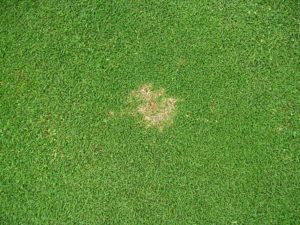
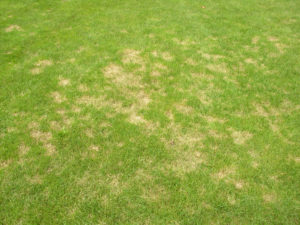
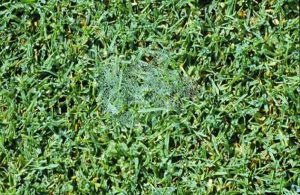
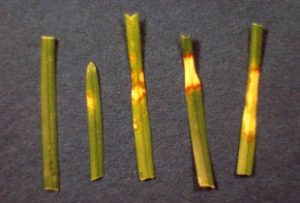
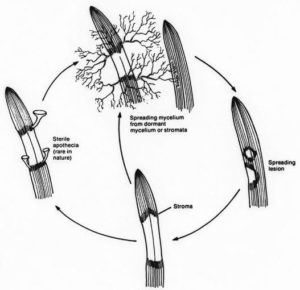
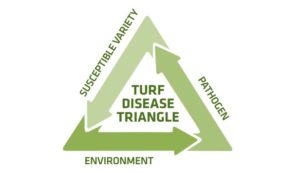
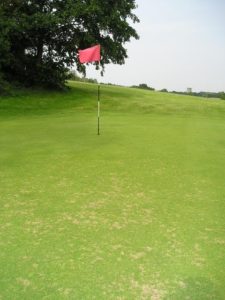

Comments are closed.